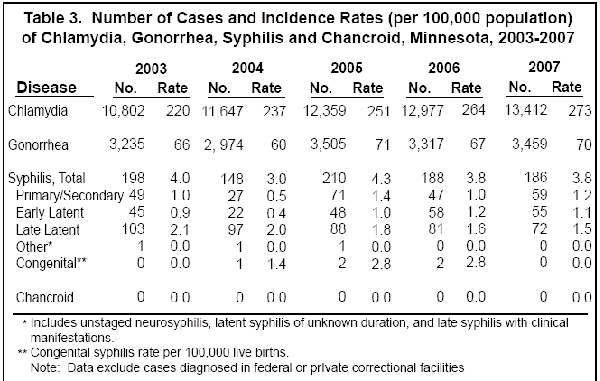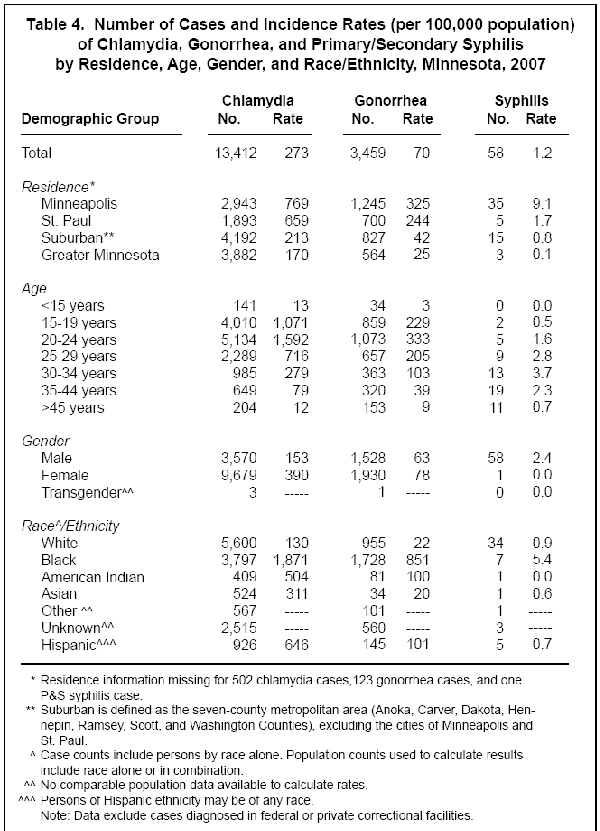Annual Summary of Disease Activity:
Disease Control Newsletter (DCN)
Related Topics
Contact Info
Sexually Transmitted Diseases, 2007
STD Diseases on this page:
Chlamydia
Gonorrhea
Syphilis
Chancroid
Active surveillance for gonorrhea and chlamydia, initiated in 2002, involves cross-checking laboratory-reported cases against cases reported by clinicians. Although both laboratories and clinical facilities are required to report STDs independently of each other, an episode of STD is not considered a case for surveillance purposes until a corresponding case report is submitted by a clinical facility. Case reports contain demographic and clinical information that is not available from laboratory reports. When a laboratory report is received but no corresponding case report is received within 45 days, MDH mails a reminder letter and case report form to the corresponding clinical facility. Active surveillance for syphilis also began in 2002 and involves immediate follow-up with the clinician upon receipt of a positive laboratory report. Cases of chancroid are monitored through a mostly passive surveillance system. Herpes simplex virus and human papillomavirus infections are not reportable.
Although overall incidence rates for STDs in Minnesota are lower than those in many other areas of the United States, certain population subgroups in Minnesota have very high STD rates. Specifically, STDs disproportionately affect adolescents, young adults, and persons of color.
Chlamydia
Chlamydia trachomatis infection is the most commonly reported STD in Minnesota. In 2007, 13,412 chlamydia cases (273 per 100,000 population) were reported, representing a 4% increase from 2006 (Table 3).
Adolescents and young adults are at highest risk for acquiring chlamydial infection (Table 4). The chlamydia rate is highest among 20 to 24-year-olds (1,592 per 100,000), with the next highest rate among 15 to 19-year-olds (1,071 per 100,000). The incidence of chlamydia among adults 25 to 29 years of age (716 per 100,000) is considerably lower but has increased in recent years. The chlamydia rate among females (390 per 100,000) is more than twice the rate among males (153 per 100,000). This difference is likely due to more frequent screening among women.
The incidence of chlamydia infection is highest in communities of color (Table 4). The rate among blacks (1,871 per 100,000) is over 14 times higher than the rate among whites (130 per 100,000). Although blacks comprise approximately 4% of Minnesota’s population, they account for 28% of reported chlamydia cases. Rates among Asian/Pacific Islanders (311 per 100,000), American Indians (504 per 100,000), and Hispanics (646 per 100,000) are two to five times higher than the rate among whites.
Chlamydia infections occur throughout the state, with the highest reported rates in Minneapolis (769 per 100,000) and St. Paul (659 per 100,000). In 2007, the greatest increases for chlamydia were seen in the suburbs and Greater Minnesota with increases of 4% and 8%, respectively.
Gonorrhea
Gonorrhea, caused by Neisseria gonorrhoeae, is the second most commonly reported STD in Minnesota. In 2007, 3,459 cases (70 per 100,000 population) were reported, representing an increase of 5% from 2006 (Table 3).
Adolescents and young adults are at greatest risk for gonorrhea (Table 4), with incidence rates of 229 per 100,000 among 15 to 19-year-olds, 333 per 100,000 among 20 to 24-year olds, and 205 per 100,000 among 25 to 29-year-olds. Gonorrhea rates for males (63 per 100,000) and females (78 per 100,000) are comparable. Communities of color are disproportionately affected by gonorrhea, with 50% of cases reported among blacks. The incidence of gonorrhea among blacks (851 per 100,000) is approximately 40 times higher than the rate among whites (22 per 100,000). Rates among American Indians (100 per 100,000) and Hispanics (101 per 100,000) are almost five times higher than among whites. The rate among Asian/Pacific Islanders (20 per 100,000) is slightly lower than among whites.
Gonorrhea rates are highest in the cities of Minneapolis and St. Paul (Table 4). The incidence in Minneapolis (325 per 100,000) is 1.3 times the rate in St. Paul (244 per 100,000), nearly eight times higher than the rate in the suburban metropolitan area (42 per 100,000), and 13 times higher than the rate in Greater Minnesota (25 per 100,000). However, the rate in Greater Minnesota is growing rapidly, with a 34% increase from 2006 to 2007.
Quinolone-resistant N. gonorrhoeae
The prevalence of quinolone-resistant N. gonorrhoeae (QRNG) has increased approximately six-fold from 1.5% in 2002 to 8.6% in 2007. Of concern is the high prevalence among men who have sex with men (MSM), which increased sharply from 0% in 2002, to 8.9% in 2003, and to 27% in 2004. Since then the prevalence among MSM has remained stable but elevated (28% in 2007). As a result, fluoroquinolones (e.g., ciprofloxacin) are no longer recommended for treating gonorrhea in men with male sexual partners in Minnesota. In 2007, QRNG prevalence also reached a critical level in heterosexuals (4.5%), prompting the MDH to recommend non-quinolone therapy for that population as well.
Syphilis
Surveillance data for primary and secondary syphilis are used to monitor morbidity trends because they represent recently acquired infections. Data for early syphilis (which includes primary, secondary, and early latent stages of disease) are used in outbreak investigations because they represent infections acquired within the past 12 months and signify opportunities for disease prevention.
Primary and Secondary Syphilis
The incidence of primary/secondary syphilis in Minnesota is lower than that of chlamydia or gonorrhea (Table 3), but has remained elevated since an outbreak was observed in 2002 among men who have sex with men (MSM). In 2007, 59 cases of primary/secondary syphilis (1.2 per 100,000 population) were reported compared to 47 (1.0 per 100,000) cases in 2006.
Early Syphilis
In 2007, the number of early syphilis cases increased by 10%, with 114 cases occurring compared to 105 cases in 2006. The incidence is highest amongst MSM, where cases increased by 29% from 2006 to 2007 (80 to 103). Of the early syphilis cases in 2007, 111 (97%) occurred among men; 103 (93%) of these men reported having sex with other men; 44% of the MSM diagnosed with early syphilis were co-infected with HIV.
Congenital Syphilis
No cases of congenital syphilis were reported in Minnesota in 2007 (Table 3).
Chancroid
Chancroid continues to be very rare in Minnesota. No cases were reported in 2007.


- For up to date information see>> Sexually Transmitted Diseases (STDs)
- Full issue>> Annual Summary of Communicable Diseases Reported to the Minnesota Department of Health, 2007